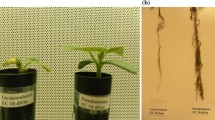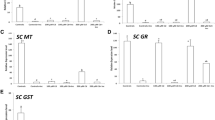Abstract
Phytate-mineralizing rhizobacteria (PMR) play an important role in providing phosphorus for the sustainable plant growth. It is important to investigate the ability of PMR to produce phytase under different phosphate levels for its application. The effects of different concentrations of soluble phosphate on the ability of phytate mineralization of Pseudomonas fluorescens JZ-DZ1, a phytate-mineralizing rhizobacterium, were investigated in both solid and liquid media. The results on solid media showed that halo zone width gradually reduced with concentrations of soluble phosphate increasing from 0.05 to 20 mM, indicating the reduction of the ability of phytate mineralization. The results were consistent with the quantitative detection of phytase activity from the overall trend. An 1866-bp β-propeller phytase (BPP) gene (phyPf) was cloned from the strain, and the deduced amino acid sequence of phyPf shared 98 % of identity with a known BPP from Pseudomonas sp. BS10-3 (AJF36073.1). The results of relative real-time quantitative PCR assay showed that the expression of phyPf was induced by a low concentration (0.1 mM) of soluble phosphate, suggesting that BPP secretion was regulated by gene phyPf. The BPP-harboring bacterium P. fluorescens JZ-DZ1 with low phosphate-inducible ability of phytate mineralization could be potentially applied to promote phosphorus uptake for plants in the future.





Similar content being viewed by others
References
Adesemoye AO, Torbert HA, Kloepper JW (2009) Plant growth-promoting rhizobacteria allow reduced application rates of chemical fertilizers. Microb Ecol 58:921–929
Batjes NH (1997) A world dataset of derived soil properties by FAO-UNESCO soil unit for global modelling. Soil Use Manag 13:9–16
Celi L, Lamacchia S, Marsan FA, Barberis E (1999) Interaction of inositol hexaphosphate on clays: adsorption and charging phenomena. Soil Sci 164:574–585
Cheng C, Lim BL (2006) Beta-propeller phytases in the aquatic environment. Arch Microbiol 185:1–13
Choi YM, Suh HJ, Kim JM (2001) Purification and properties of extracellular phytase from Bacillus sp. KHU-10. J Protein Chem 20:287–292
Cho J, Lee C, Kang S, Lee J, Lee H, Bok J, Woo J, Moon Y, Choi Y (2005) Molecular cloning of a phytase gene (phy M) from Pseudomonas syringae MOK1. Curr Microbiol 51:11–15
Chu HM, Guo RT, Lin TW, Chou CC, Shr HL, Lai HL, Tang TY, Cheng KJ, Selinger BL, Wang J (2004) Structures of Selenomonas ruminantium phytase in complex with persulfated phytate: DSP phytase fold and mechanism for sequential substrate hydrolysis. Structure 12:2015–2024
Gebert S, Siegel D, Wellinghausen N (2008) Rapid detection of pathogens in blood culture bottles by real-time PCR in conjunction with the pre-analytic tool MolYsis. J Infect 57:307–316
George TS, Richardson AE, Li SS, Gregory PJ, Daniell TJ (2009) Extracellular release of a heterologous phytase from roots of transgenic plants: does manipulation of rhizosphere biochemistry impact microbial community structure? FEMS Microbiol Ecol 70:433–445
George TS, Simpson RJ, Hadobas PA, Richardson AE (2005) Expression of a fungal phytase gene in Nicotiana tabacum improves phosphorus nutrition of plants grown in amended soils. Plant Biotechnol J 3:129–140
Gyaneshwar P, Parekh LJ, Archana G, Poole PS, Collins MD, Hutson RA, Kumar G (1999) Involvement of a phosphate starvation inducible glucose dehydrogenase in soil phosphate solubilization by Enterobacter asburiae. FEMS Microbiol Lett 171:223–229
Hayat R, Ali S, Amara U, Khalid R, Ahmed I (2010) Soil beneficial bacteria and their role in plant growth promotion: a review. Ann Microbiol 60:579–598
Hayes JE, Richardson AE, Simpson RJ (1999) Phytase and acid phosphatase activities in extracts from roots of temperate pasture grass and legume seedlings. Funct Plant Biol 26:801–809
Holman WIM (1943) A new technique for the determination of phosphorus by the molybdenum blue method. Biochem J 37:256
Howson SJ, Davis RP (1983) Production of phytate-hydrolysing enzyme by some fungi. Enzyme Microbial Technol 5:377–382
Huang H, Shao N, Wang Y et al (2009) A novel beta-propeller phytase from Pedobacter nyackensis MJ11 CGMCC 2503 with potential as an aquatic feed additive. Appl Microbiol Biotechnol 83:249–259
Huang HQ, Shi PJ, Wang Y, Luo HY, Shao N, Wang GZ, Yang PL, Yao B (2009) Diversity of beta-propeller phytase genes in the intestinal contents of grass carp provides insight into the release of major phosphorus from phytate in nature. Appl Environ Microbiol 75:1508–1516
Idriss EE, Makarewicz O, Farouk A, Rosner K, Greiner R, Bochow H, Richter T, Borriss R (2002) Extracellular phytase activity of Bacillus amyloliquefaciens FZB45 contributes to its plant-growth-promoting effect. Microbiology 148:2097–2109
Jakobsen I, Leggett ME, Richardson AE (2005) Rhizosphere microorganisms and plant phosphorus uptake. Agronomy 46:437
Jorquera MA, Crowley DE, Marschner P, Greiner R, Fernandez MT, Romero D, Blackburn DM, Mora MD (2011) Identification of β-propeller phytase-encoding genes in culturable Paenibacillus and Bacillus spp. from the rhizosphere of pasture plants on volcanic soils. FEMS Microbiol Ecol 75:163–172
Jorquera MA, Inostroza NG, Lagos LM, Barra PJ, Marileo LG, Rilling JI, Campos DC, Crowley DE, Richardson AE, Mora ML (2014) Bacterial community structure and detection of putative plant growth-promoting rhizobacteria associated with plants grown in Chilean agro-ecosystems and undisturbed ecosystems. Biol Fertil Soils 50:1141–1153
Jorquera MA, Martinez O, Maruyama F, Marschner P, Mora MD (2008) Current and future biotechnological applications of bacterial phytases and phytase-producing bacteria. Microbes Environ 23:182–191
Jorquera MA, Saavedra N, Maruyama F, Richardson AE, Crowley DE, Catrilaf RC, Henriquez EJ, Mora ML (2013) Phytate addition to soil induces changes in the abundance and expression of Bacillus β-propeller phytase genes in the rhizosphere. FEMS Microbiol Ecol 83:352–360
Kalsi HK, Singh R, Dhaliwal HS, Kumar V (2016) Phytases from Enterobacter and Serratia species with desirable characteristics for food and feed applications. 3. Biotech 6:1–13
Kang S, Denman SE, Morrison M, Yu Z, McSweeney CS (2009) An efficient RNA extraction method for estimating gut microbial diversity by polymerase chain reaction. Curr Microbiol 58:464–471
Kerovuo J, Rouvinen J, Hatzack F (2000) Analysis of myo-inositol hexakisphosphate hydrolysis by Bacillus phytase: indication of a novel reaction mechanism. Biochem J 352:623–628
Kumar V, Singh P, Jorquera MA, Sangwan P, Kumar P, Verma AK, Agrawal S (2013) Isolation of phytase-producing bacteria from Himalayan soils and their effect on growth and phosphorus uptake of Indian mustard (Brassica juncea). World J Microbiol Biotechnol 29:1361–1369
Le Saux A, Houdebine LM, Jolivet G (2010) Chromosome integration of BAC (bacterial artificial chromosome): evidence of multiple rearrangements. Transgenic Res 19:923–931
Lewis DC, Sale PWG (1993) Management of nutrients for pastures. In: Kemp DR, Michalk DL (eds) Pasture management technology for the 21st century. CSIRO Publishing, Melbourne, pp 38–50
Li GE, Wu XQ, Ye JR, Hou L, Zhou AD, Zhao L (2013) Isolation and identification of phytate-degrading rhizobacteria with activity of improving growth of poplar and Masson pine. World J Microbiol Biotechnol 29:2181–2193
Li M, Osaki M, Rao IM, Tadano T (1997) Secretion of phytase from the roots of several plant species under phosphorus-deficient conditions. Plant Soil 195:161–169
Lim BL, Yeung P, Cheng C, Hill JE (2007) Distribution and diversity of phytate-mineralizing bacteria. ISME J 1:321–330
Liu YG, Huang N (1998) Efficient amplification of insert end sequences from bacterial artificial chromosome clones by thermal asymmetric interlaced PCR. Plant Mol Biol Rep 16:175–175
Livak KJ, Schmittgen TD (2001) Analysis of relative gene expression data using real-time quantitative PCR and the 2−ΔΔCt method. Methods 25:402–408
Lung SC, Chan WL, Yip W, Wang L, Yeung EC, Lim BL (2005) Secretion of beta-propeller phytase from tobacco and Arabidopsis roots enhances phosphorus utilization. Plant Sci 169:341–349
Lung SC, Lim BL (2006) Assimilation of phytate-phosphorus by the extracellular phytase activity of tobacco (Nicotiana tabacum) is affected by the availability of soluble phytate. Plant Soil 279:187–199
Mullaney EJ, Ullah AHJ (2003) The term phytase comprises several different classes of enzymes. Biochem Biophys Res Commun 312:179–184
Nam SJ, Kim YO, Ko TK, Kang JK, Chun KH, Auh JH, Lee CS, Lee IK, Park SH, Oh BC (2014) Molecular and biochemical characteristics of β-propeller phytase from marine Pseudomonas sp. BS10-3 and its potential application for animal feed additives. J Microbiol Biotechnol 24:1413–1420
Park I, Cho J (2011) The phytase from antarctic bacterial isolate, Pseudomonas sp. JPK 1 as a potential tool for animal agriculture to reduce manure phosphorus excretion. Afr J Agric Res 6:1398–1406
Qin X, Emerson J, Stapp J, Stapp L, Abe P, Burns JL (2003) Use of real-time PCR with multiple targets to identify Pseudomonas aeruginosa and other nonfermenting gram-negative bacilli from patients with cystic fibrosis. J Clin Microbiol 41:4312–4317
Raghothama KG (1999) Phosphate acquisition. Annu Rev Plant Biol 50:665–693
Richardson AE, Hadobas PA, Hayes JE (2000) Acid phosphomonoesterase and phytase activities of wheat (Triticum aestivum L.) roots and utilization of organic phosphorus substrates by seedlings grown in sterile culture. Plant Cell Environ 23:397–405
Richardson AE, Hadobas PA, Hayes JE (2001) Extracellular secretion of Aspergillus phytase from Arabidopsis roots enables plants to obtain phosphorus from phytate. Plant J 25:641–649
Richardson AE (2001) Prospects for using soil microorganisms to improve the acquisition of phosphorus by plants. Funct Plant Biol 28:897–906
Rodriguez E, Han Y, Lei XG (1999) Cloning, sequencing, and expression of an Escherichia coli acid phosphatase/phytase gene (appA2) isolated from pig colon. Biochem Biophys Res Commun 257:117–123
Rodriguez H, Fraga R (1999) Phosphate solubilizing bacteria and their role in plant growth promotion. Biotechnol Adv 17:319–339
Sajidan A, Farouk A, Greiner R, Jungblut P, Muller EC, Borriss R (2004) Molecular and physiological characterisation of a 3-phytase from soil bacterium Klebsiella sp. ASR1. Appl Microbiol Biotechnol 65:110–118
Selle PH, Ravindran V, Caldwell A, Bryden WL (2000) Phytate and phytase: consequences for protein utilisation. Nutr Res Rev 13:255–278
Singh P, Kumar V, Agrawal S (2014) Evaluation of phytase producing bacteria for their plant growth promoting activities. Int J Microbiol. doi:10.1155/2014/426483
Turner BL, Paphazy MJ, Haygarth PM, Mckelvie ID (2002) Inositol phosphates in the environment. Philos Trans Royal Soc B 357:449–469
Ullah AHJ (1988) Production, rapid purification and catalytic characterization of extracellular phytase from Aspergillus ficuum. Prep Biochem 18:443–458
Zeng QW, Wu XQ, Wen XY (2016) Effects of soluble phosphate on phosphate-solubilizing characteristics and expression of gcd gene in Pseudomonas frederiksbergensis JW-SD2. Curr Microbiol 72:198–206
Zhang R, Yang PL, Huang HQ, Yuan TZ, Shi PJ, Meng K, Yao B (2011) Molecular and biochemical characterization of a new alkaline β-propeller phytase from the insect symbiotic bacterium Janthinobacterium sp. TN115. Appl Microbiol Biotechnol 92:317–325
Zhang R, Yang PL, Huang H, Shi PJ, Yuan TZ, Yao B (2011) Two types of phytases (histidine acid phytase and β-propeller phytase) in Serratia sp. TN49 from the gut of Batocera horsfieldi (Coleoptera) larvae. Curr Microbiol 63:408–415
Zimmermann P, Zardi G, Lehmann M, Zeder C, Amrhein N, Frossard E, Bucher M (2003) Engineering the root–soil interface via targeted expression of a synthetic phytase gene in trichoblasts. Plant Biotechnol J 1:353–360
Acknowledgments
This research was supported by the Chinese Special Research Program for Forestry Sectors Beneficial to Public (201304404, 201004061) and the Priority Academic Program Development of Jiangsu Higher Education Institutions (PAPD). The authors express their gratitude to Dr. De-Wei Li, The Connecticut Agricultural Experiment Station, USA and Dr. Hui Sun, Nanjing Forestry University, China for reviewing the manuscript.
Author information
Authors and Affiliations
Corresponding author
Ethics declarations
Conflict of Interest
The authors declare that they have no conflict of interest.
Rights and permissions
About this article
Cite this article
Shen, L., Wu, XQ., Zeng, QW. et al. Regulation of Soluble Phosphate on the Ability of Phytate Mineralization and β-Propeller Phytase Gene Expression of Pseudomonas fluorescens JZ-DZ1, a Phytate-Mineralizing Rhizobacterium. Curr Microbiol 73, 915–923 (2016). https://doi.org/10.1007/s00284-016-1139-0
Received:
Accepted:
Published:
Issue Date:
DOI: https://doi.org/10.1007/s00284-016-1139-0




